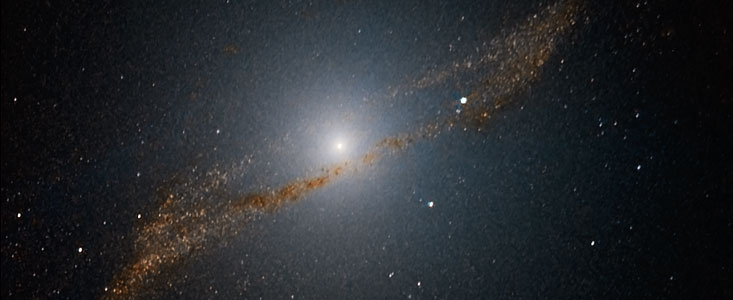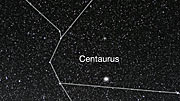Pressmeddelande
Kannibalgalaxens senaste middag
20 november 2009
Ett nytt sätt att behandla bilder tagna i infrarött ljus med ESO:s 3,58-meters New Technology Telescope (NTT) har avslöjat en gigantisk kannibalgalax - och dess senaste måltid. Med den nya metoden har astronomer kunnat se igenom de mörka stoftstråken i galaxen Centaurus A och observera "maten", en liten spiralgalax, för närvarande förvriden och skev, i aldrig tidigare skådad detalj. Denna otroliga bild visar även tusentals stjärnhopar, utströdda som glimmande juveler, som virvlar runt inne i Centaurus A.
Centaurus A, eller NGC 5128, är vår närmast elliptiska jättegalax och ligger vid ett avstånd av ungefär 11 miljoner ljusår. Den är ett av den södra stjärnhimlens flitigast studerade objekt. Den fångade den brittiske astronomen John Herschels uppmärksamhet redan 1847 och kom med i hans omfattande lista över den södra himlens nebulosor.
Herschel kunde dock inte veta att galaxens vackra och spektakulära utseende beror på ett ogenomskinligt stoftband som täcker galaxens centrala del. Stoftet tros vara resterna efter en kosmisk sammansmältning mellan en elliptisk jättegalax och en mindre spiralgalax.
Mellan 200 och 700 miljoner år sedan förefaller det att vara sedan denna galax åt upp en mindre, gasrik spiralgalax. Det är denna mindre galax vars rester nu verkar malas runt inne i de centrala delarna av Centaurus A och sannolikt sätter igång bildandet av nya generationer av stjärnor.
Skymtar av resterna efter galaxens måltid har tidigare setts tack vare observationer med ESA:s Infrared Space Observatory . Det avslöjade en 16 500 ljusår bred struktur, som påminde starkt om en liten stavspiralgalax.
Nyligen kunde NASA:s rymdteleskop Spitzer upplösa strukturen som ett parallellogram. Formen kan förklaras som resten efter en gasrik spiralgalax som fallit in i en elliptisk galax och som förvridits under resans gång. Sammansmältning av galaxer är det vanligaste sättet att förklara hur sådana elliptiska jättegalaxer bildas.
Med de nya bilderna, tagna med instrumentet SOFI och teleskopet NTT vid ESO:s La Silla-observatorium, har astronomerna kunnat få en ännu skarpare bild av galaxens struktur, denna gång helt fri från skymmande stoft. De ursprungliga bilderna, som togs i nära infrarött ljus genom tre olika filter (J, H och K), kombinerades med en ny metod som tar bort stoftets mörka, skärmande påverkan och ger en klar bild av galaxens mitt.
Det som astronomerna hittade där kom som en överraskning, menar Jouni Kainulainen, första författare till en artikel som beskriver forskningsresultaten. - Det finns en tydlig ring av stjärnor och stjärnhopar som ligger dolda bakom stoftstråken, och våra bilder visar den i aldrig tidigare uppnådd detalj, säger han. Vidare analys av dess struktur kommer att ge viktiga ledtrådar hur sammansmältningen gått till och vad stjärnbildning haft för roll under processen.
Forskarteamet ser fram mot den nya metodens spännande möjligheter.
- Detta är de första stegen mot att utveckla en ny metod som gör det möjligt att spåra jättelika gasmoln i andra galaxer vid hög upplösning och på ett kostnadseffektivt sätt, förklarar medförfattaren João Alves. Om man vet hur dessa jättemoln bildas kan man förstå hur stjärnor bildas i galaxer.
Nu blickar man framåt mot nya planerade teleskop, både på marken och i rymden.
- Denna metod kompletterar de radiodata som ALMA kommer att samla in om näraliggande galaxer, och samtidigt öppnar den intressanta forskningsvägar rörande extragalaktiska stjärnpopulationer med det framtida European Extremely Large Telescope och James Webb Space Telescope, då stoft finns överallt i galaxer, säger medförfattare Yuri Beletsky.
Tidigare observationer gjorda med ISAAC på VLT har avslöjat att ett supertungt svart hål döljer sig inne i Centaurus A. Dess massa är ungefär 200 miljoner gånger solens, eller 50 gånger tyngre än det som ligger i centrum av vår egen Vintergata. I kontrast till hos vår egen galax matas det supertunga svarta hålet i Centaurus A kontinuerligt med materia som faller in i det, vilket gör galaxen till en mycket s.k aktiv galax. Centaurus A är faktiskt en av de starkaste radiokällorna på himlen (därav "A"-et i namnet). Strålar med högenergetiska partiklar observeras också i avbildningar gjorda med radio- och röntgenstrålning.
Den nya bilden av Centaurus A är ett underbart exempel på hur vetenskap på forskningsfronten kan kombineras med estetiska aspekter. Fina bilder på Centaurus A har tidigare fångats av ESO:s Very Large Telescope (ESO PR Photo 05b/00) och med vidvinkelkameran WFI på MPG/ESO 2,2-meters teleskopet vid La Silla.
Mer information
Forskningsresultaten presenterades i en artikel som publicerats i tidskriften Astronomy and Astrophysics (vol. 502): "Uncovering the kiloparsec-scale stellar ring of NGC5128", av J. T. Kainulainen m. fl.
Forskarteamet består av J. T. Kainulainen (Helsingfors universitet, Finland och MPIA, Tyskland), J. F. Alves (Calar Alto-observatoriet, Spanien och Wiens universitet, Österrike), Y. Beletsky (ESO), J. Ascenso (Harvard-Smithsonian Center for Astrophysics, USA), J. M. Kainulainen (Institutionen för radiovetenskap och -teknik, Tekniska högskolan, Helsingfors), A. Amorim, J. Lima, F. D. Santos och A. Moitinho (SIM-IDL, Lissabons universitet, Portugal), R. Marques och J. Pinhão (Coimbra universitet, Portugal) och J. Rebordão (INETI, Amadora, Portugal).
Länkar
Forksningsartikel: http://www.aanda.org/10.1051/0004-6361/200912624
Mer om Centaurus A (på engelska): http://www.extragalactic.info/cena/
Kontakter
Jouni Kainulainen
MPIA
Germany
Tel: +49-6221-528427
E-post: jtkainul@mpia-hd.mpg.de
Yuri Beletsky
ESO
Chile
Tel: +56 55 43 5311
E-post: ybialets@eso.org
João Alves
Calar Alto Observatory
Spain
Tel: +34 950 632 501
E-post: jalves@caha.es
Johan Warell (Presskontakt för Sverige)
ESO:s nätverk för vetenskaplig kommunikation
Skurup, Sverige
Tel: +46-706-494731
E-post: eson-sweden@eso.org
Om pressmeddelandet
| Pressmeddelande nr: | eso0944sv |
| Legacy ID: | PR 44/09 |
| Namn: | Centaurus A, NGC 5128 |
| Typ: | Local Universe : Galaxy : Type : Elliptical Local Universe : Galaxy : Component : Central Black Hole |
| Facility: | New Technology Telescope, Very Large Telescope |
| Instruments: | NACO, SOFI |
| Science data: | 2009A&A...502L...5K |
Our use of Cookies
We use cookies that are essential for accessing our websites and using our services. We also use cookies to analyse, measure and improve our websites’ performance, to enable content sharing via social media and to display media content hosted on third-party platforms.
ESO Cookies Policy
The European Organisation for Astronomical Research in the Southern Hemisphere (ESO) is the pre-eminent intergovernmental science and technology organisation in astronomy. It carries out an ambitious programme focused on the design, construction and operation of powerful ground-based observing facilities for astronomy.
This Cookies Policy is intended to provide clarity by outlining the cookies used on the ESO public websites, their functions, the options you have for controlling them, and the ways you can contact us for additional details.
What are cookies?
Cookies are small pieces of data stored on your device by websites you visit. They serve various purposes, such as remembering login credentials and preferences and enhance your browsing experience.
Categories of cookies we use
Essential cookies (always active): These cookies are strictly necessary for the proper functioning of our website. Without these cookies, the website cannot operate correctly, and certain services, such as logging in or accessing secure areas, may not be available; because they are essential for the website’s operation, they cannot be disabled.
Functional Cookies: These cookies enhance your browsing experience by enabling additional features and personalization, such as remembering your preferences and settings. While not strictly necessary for the website to function, they improve usability and convenience; these cookies are only placed if you provide your consent.
Analytics cookies: These cookies collect information about how visitors interact with our website, such as which pages are visited most often and how users navigate the site. This data helps us improve website performance, optimize content, and enhance the user experience; these cookies are only placed if you provide your consent. We use the following analytics cookies.
Matomo Cookies:
This website uses Matomo (formerly Piwik), an open source software which enables the statistical analysis of website visits. Matomo uses cookies (text files) which are saved on your computer and which allow us to analyze how you use our website. The website user information generated by the cookies will only be saved on the servers of our IT Department. We use this information to analyze www.eso.org visits and to prepare reports on website activities. These data will not be disclosed to third parties.
On behalf of ESO, Matomo will use this information for the purpose of evaluating your use of the website, compiling reports on website activity and providing other services relating to website activity and internet usage.
Matomo cookies settings:
Additional Third-party cookies on ESO websites: some of our pages display content from external providers, e.g. YouTube.
Such third-party services are outside of ESO control and may, at any time, change their terms of service, use of cookies, etc.
YouTube: Some videos on the ESO website are embedded from ESO’s official YouTube channel. We have enabled YouTube’s privacy-enhanced mode, meaning that no cookies are set unless the user actively clicks on the video to play it. Additionally, in this mode, YouTube does not store any personally identifiable cookie data for embedded video playbacks. For more details, please refer to YouTube’s embedding videos information page.
Cookies can also be classified based on the following elements.
Regarding the domain, there are:
- First-party cookies, set by the website you are currently visiting. They are stored by the same domain that you are browsing and are used to enhance your experience on that site;
- Third-party cookies, set by a domain other than the one you are currently visiting.
As for their duration, cookies can be:
- Browser-session cookies, which are deleted when the user closes the browser;
- Stored cookies, which stay on the user's device for a predetermined period of time.
How to manage cookies
Cookie settings: You can modify your cookie choices for the ESO webpages at any time by clicking on the link Cookie settings at the bottom of any page.
In your browser: If you wish to delete cookies or instruct your browser to delete or block cookies by default, please visit the help pages of your browser:
Please be aware that if you delete or decline cookies, certain functionalities of our website may be not be available and your browsing experience may be affected.
You can set most browsers to prevent any cookies being placed on your device, but you may then have to manually adjust some preferences every time you visit a site/page. And some services and functionalities may not work properly at all (e.g. profile logging-in, shop check out).
Updates to the ESO Cookies Policy
The ESO Cookies Policy may be subject to future updates, which will be made available on this page.
Additional information
For any queries related to cookies, please contact: pdprATesoDOTorg.
As ESO public webpages are managed by our Department of Communication, your questions will be dealt with the support of the said Department.




